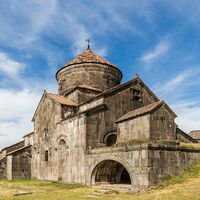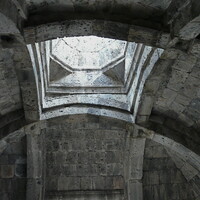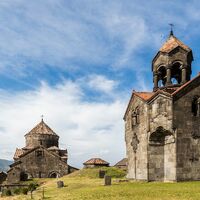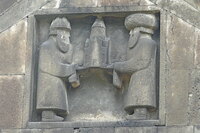Haghpat Monastery
Type:
Churches,
Khachkars,
Monasteries,
Sculptures
Date:
late tenth century (Surb Nshan church),
1273 (khatchkar of Yovhannes)
Location or Findspot (Modern-Day Country):
Armenia
Description:
Monasteries were built in Armenia from the fifth century on, and Haghpat is one of the best preserved. Its main domed church, dedicated to the Holy Sign (Surb Nshan), was founded around 970 by the Bagratid-dynasty queen Khosrovanush, wife of King Ashot III of Ani (r. 952–77). Her two sons completed the building in 991 and are represented on the east facade, just below the roof, holding a model of the church. Smbat (r. 977–89) wears a turban that the Abbasid caliph permitted the Bagratid kings to wear, and his brother, Gurgen, wears caplike helmet. Such images of donation are common on the exterior of churches in Armenia and Georgia.
Two more churches were added to the monastery between the eleventh and thirteenth centuries, as were a refectory, a three-story bell tower, a scriptorium, and a zhamatun or gavit' ("house of hours"). Such a space was often built against the west facade of Armenian churches to accommodate large gatherings. At Haghpat it is roofed with intersecting ribbed arches; it is open to the sky at the center. A pointed canopy over the opening echoes the conical cupola of the church and the pyramid-shaped roofs of the refectory and scriptorium. This contributes to the unified impression of the site, in which the separate buildings were connected by rooms and corridors.
In addition to abundant architectural sculpture, Haghpat has several carved khatchkars and tombstones. The most imposing khachkar was installed next to the main church in 1273 by the abbot Yovhannes, whose personal prayer is one of numerous inscriptions. This is one of a small group of khatchkars that depicts a figural Crucifixion rather than the lacelike ornament seen on the khatchkar of Goshavank. Flanking Jesus on the cross are Mary and John, and below them are Joseph of Arimathea and Nicodemus, whose presence at the event was recorded in the Gospels (Joseph in all four, Nicodemus only in John). Above Jesus are more men, angels, and personifications of the sun and moon (Luke 23:44); along the sides are twelve small apostles. Christ's Ascension to heaven appears above. Painted images like this were relatively rare in medieval Armenia and may reflect inspiration from Byzantine or Georgian icons; a thirteenth-century Armenian theologian wrote that "Greeks and Georgians honored the images more; the Armenians [honored] the cross."
Two more churches were added to the monastery between the eleventh and thirteenth centuries, as were a refectory, a three-story bell tower, a scriptorium, and a zhamatun or gavit' ("house of hours"). Such a space was often built against the west facade of Armenian churches to accommodate large gatherings. At Haghpat it is roofed with intersecting ribbed arches; it is open to the sky at the center. A pointed canopy over the opening echoes the conical cupola of the church and the pyramid-shaped roofs of the refectory and scriptorium. This contributes to the unified impression of the site, in which the separate buildings were connected by rooms and corridors.
In addition to abundant architectural sculpture, Haghpat has several carved khatchkars and tombstones. The most imposing khachkar was installed next to the main church in 1273 by the abbot Yovhannes, whose personal prayer is one of numerous inscriptions. This is one of a small group of khatchkars that depicts a figural Crucifixion rather than the lacelike ornament seen on the khatchkar of Goshavank. Flanking Jesus on the cross are Mary and John, and below them are Joseph of Arimathea and Nicodemus, whose presence at the event was recorded in the Gospels (Joseph in all four, Nicodemus only in John). Above Jesus are more men, angels, and personifications of the sun and moon (Luke 23:44); along the sides are twelve small apostles. Christ's Ascension to heaven appears above. Painted images like this were relatively rare in medieval Armenia and may reflect inspiration from Byzantine or Georgian icons; a thirteenth-century Armenian theologian wrote that "Greeks and Georgians honored the images more; the Armenians [honored] the cross."
Relevant Textbook Chapter(s):
6,
9
Repository and Online Resources:
• Haghpat Monastery is a UNESCO World Heritage site.
• View a 3D model of the monastery by Iconem Exploration here.
Image Credits:
Wikimedia Commons, Flickr







